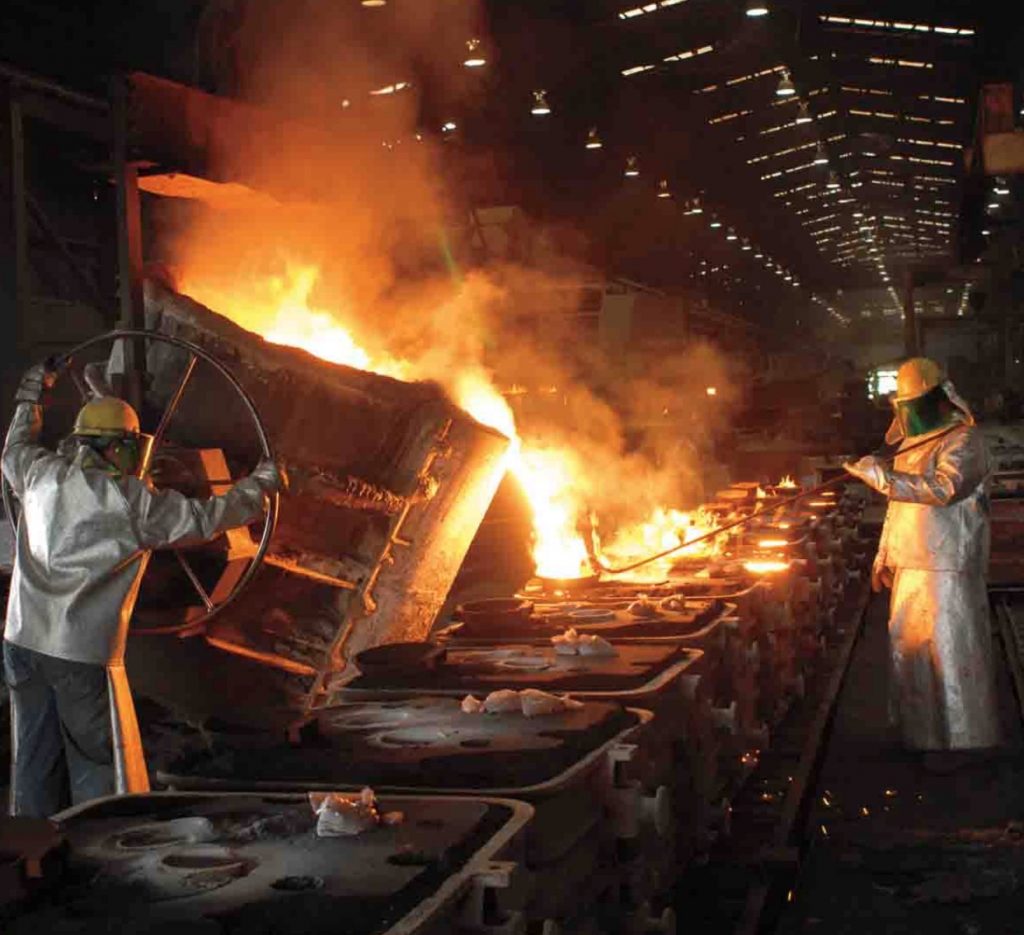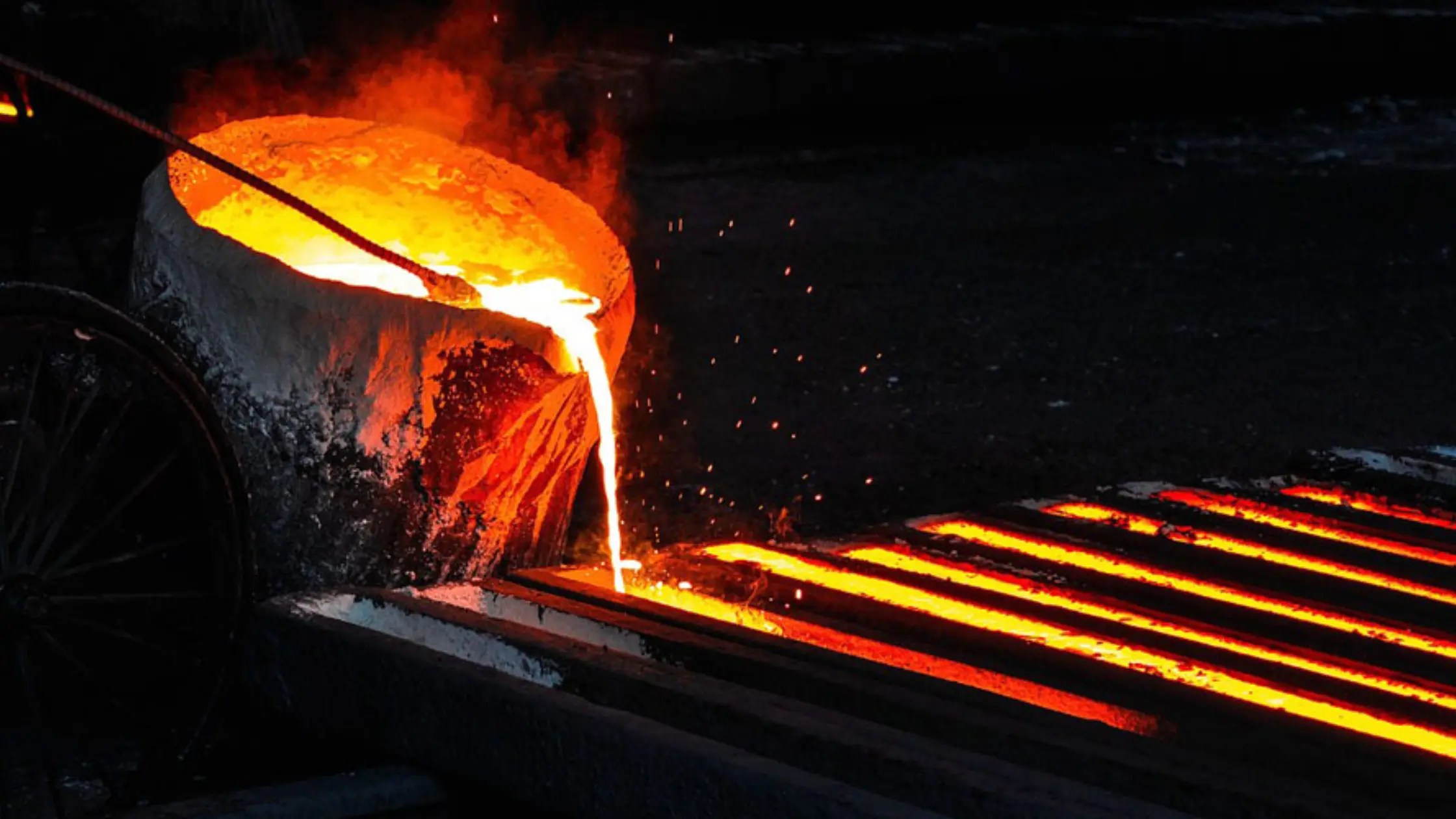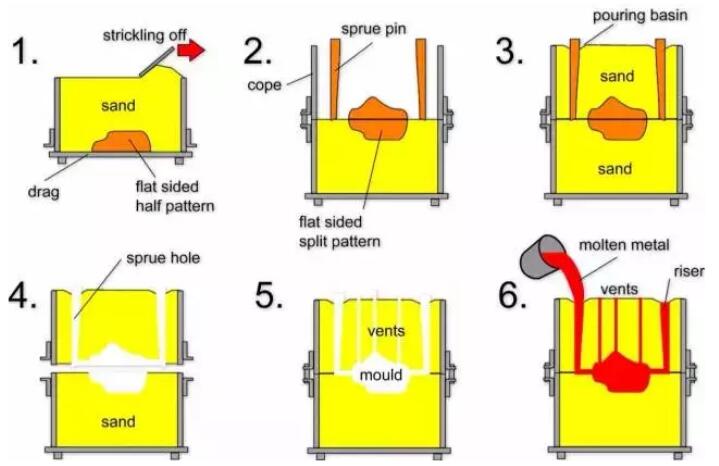Recognizing the Metal Castings Refine: A Comprehensive Overview for Beginners
The Metal Casting process is a basic technique in making that transforms molten metal into solid kinds. Newbies should understand the various techniques entailed, such as sand spreading and die spreading. Recognizing the materials, layout concepts, and safety and security actions is just as vital. Each facet plays a crucial function in attaining successful end results. As one browses these ins and outs, the concern of how to enhance each step for enhanced outcomes becomes increasingly essential.
The Fundamentals of Steel Casting
Metal Casting has actually progressed over centuries, its fundamental concepts continue to be regular and essential to the production process. At its core, Metal Casting involves the improvement of liquified metal into solid things with different strategies. The process starts with the production of a mold and mildew, which defines the form of the end product. When the mold is prepared, steel is heated to its melting point and put into the tooth cavity. After cooling, the steel solidifies, taking the shape of the mold and mildew.
There are numerous casting techniques, consisting of sand spreading, financial investment casting, and die spreading, each with one-of-a-kind benefits and applications. The choice of strategy depends on variables such as manufacturing volume, product type, and wanted accuracy. As soon as cast, the last item may undertake extra processes like machining or surface treatment to accomplish the called for coating and specs. Recognizing these fundamentals is necessary for any person interested in the area of Metal Casting.

Understanding Materials Utilized in Steel Casting
Products play an essential duty in the Metal Casting process, affecting the last product's residential or commercial properties and efficiency. Numerous steels are used, consisting of aluminum, steel, iron, and bronze, each offering distinctive features matched for specific applications. Aluminum is lightweight and corrosion-resistant, making it excellent for automobile parts. Iron, particularly cast iron, is favored for its superb wear resistance and longevity. Steel offers high stamina and convenience, usually utilized in heavy equipment elements. Bronze, understood for its deterioration resistance and machinability, is typically employed in marine applications.
In enhancement to the steels, various casting products, such as sand, plaster, and ceramic, are made use of to create mold and mildews. Sand spreading, the most common approach, utilizes silica sand due to its thermal security and ability to form complex shapes. Plaster and ceramic molds provide finer details but may call for more complex procedures. The option of materials directly affects the performance, cost, and top quality of the spreading procedure.
The Design Refine: From Concept to Blueprint
The layout procedure in Metal Casting starts with the preliminary idea growth, where concepts are produced and examined. This is adhered to by the application of CAD modeling methods, enabling specific visualizations of the style. The blueprint completion steps assure that all specifications are properly documented for manufacturing.
Preliminary Idea Advancement
First idea advancement marks an essential phase in the Metal Casting procedure, where ideas transform into tangible layouts. Throughout this stage, designers work together with stakeholders and designers to brainstorm and fine-tune first ideas. They consider aspects such as performance, aesthetic appeals, and manufacturability, ensuring that the layout fulfills the needed specifications and efficiency requirements. Illustrations and outlines are developed to envision the principles, enabling preliminary assessments of expediency and cost-effectiveness. This phase likewise involves determining products and potential casting approaches that straighten with the design goals. Eventually, preliminary concept advancement lays the foundation for a comprehensive blueprint, directing the succeeding phases of the spreading procedure and guaranteeing a successful shift from idea to reality.
CAD Modeling Techniques
Changing concepts into specific designs, CAD modeling strategies play a crucial duty in the Metal Casting procedure. These strategies make use of advanced software application to produce thorough three-dimensional versions that accurately reflect the intended product. By using devices such as parametric modeling, solid modeling, and surface area modeling, designers can control dimensions and shapes easily. CAD systems likewise help with simulation and evaluation, enabling the identification of prospective imperfections prior to production starts. This aggressive method minimizes product waste and maximizes the style for manufacturability. Furthermore, CAD designs can be easily changed, allowing quick models based on responses. Fundamentally, CAD modeling works as the backbone of the layout procedure, bridging the space in between initial principles and the eventual production-ready layouts.
Blueprint Finalization Steps
Adhering to the production of thorough CAD versions, the following phase entails plan finalization, which is essential in equating digital designs into workable prepare for production. This process starts with assessing the CAD models for accuracy and compliance with specs. As soon as validated, the dimensions, tolerances, and product requirements are meticulously outlined to ensure clarity. Including notes and notes assists communicate necessary info relating to casting procedures, surface finishes, and setting up needs. The finalized plan goes through a rigorous approval procedure, typically involving collaboration with engineers and manufacturing teams to attend to any possible concerns. Besides modifications are made and authorizations acquired, the plan is formally released, acting as the fundamental file for the subsequent phases of Metal Casting, including pattern production and mold layout.
The Steel Casting Methods Explained

Metal Casting strategies include a variety of methods used to form liquified metal into preferred types. These techniques vary according to the sort of product, complexity of the layout, and manufacturing volume. Sand spreading is one of the most usual methods, involving the creation of a mold and mildew from sand to hold the molten metal. Financial investment spreading, or lost-wax casting, enables complex styles by making use of a wax pattern that is dissolved. Pass away casting employs high-pressure shot of liquified metal into a mold, suitable for mass manufacturing. Other techniques consist of irreversible mold casting, which utilizes recyclable mold and mildews, and centrifugal spreading, where rotational forces help in loading the mold and mildew. Each technique has its advantages and applications, making it essential for producers to choose the proper method based upon their specific needs and requirements. Understanding these methods is essential for any individual included in the Metal Casting procedure.
Completing Procedures: Enhancing Your Casted Product

Finishing procedures play an important my link role in improving the quality and appearance of casted items. Numerous surface therapy strategies, such as sprucing up and finish, are employed to enhance resilience and aesthetics. wikipedia reference Additionally, high quality evaluation approaches ensure that the end product meets defined criteria and performance requirements.
Surface Area Treatment Techniques
A selection of surface treatment techniques play a necessary function in boosting the top quality and long life of casted items. These methods consist of techniques such as shot blasting, brightening, and coating. Shot blowing up properly gets rid of surface area blemishes, improving the functional and aesthetic features of the casting. Sprucing up supplies a smooth coating, which is especially essential for ornamental applications and parts calling for very little friction. Layer methods, such as electroplating or powder finishing, deal extra protection against rust and wear, guaranteeing durability. Surface therapies can enhance bond for succeeding procedures, such as painting or bonding. By using these approaches, producers can attain superior surface area quality, which is essential for the performance and life expectancy of Metal Casting in various applications.
High Quality Examination Approaches
Efficient quality inspection approaches are necessary for assuring the stability and performance of casted products after the finishing procedures. Various techniques are employed to assess the quality of Metal Casting, including aesthetic inspection, dimensional checks, and non-destructive testing (NDT) Visual evaluation enables the recognition of surface area defects, while dimensional checks ensure that products satisfy specified resistances. NDT methods, such as ultrasonic testing and radiographic examination, give deeper insights into internal honesty without damaging the castings. Furthermore, mechanical testing, such as tensile and solidity examinations, assesses product residential properties - Aluminum Castings. By employing a combination of these techniques, suppliers can enhance product quality and dependability, ultimately resulting in higher client fulfillment and decreased production costs
Security Considerations in Metal Casting
While the Metal Casting process provides countless advantages, it additionally presents a variety of safety threats that have to be very carefully handled. Workers in casting centers are revealed to heats, liquified steels, and unsafe materials, which can cause serious injuries if proper safety measures are not taken. Personal protective tools (PPE) such as heat-resistant handwear covers, deal with shields, and safety clothing is crucial to lessen risks.
Additionally, the visibility of fumes and dust demands proper ventilation systems to ensure air high quality - Wisconsin Aluminum Foundry. Normal training on security methods is crucial for all staff members to acknowledge prospective risks and react efficiently. Emergency treatments must be established, consisting of fire security actions and first help schedule. Upkeep of equipment and correct handling of materials further add to a much safer working environment. By prioritizing these safety and security considerations, Metal Casting operations More Info can safeguard their labor force and keep efficient manufacturing processes
Regularly Asked Questions
What Are the Ecological Influences of Metal Casting?
Metal Casting can bring about ecological impacts such as air and water air pollution, resource depletion, and power intake. Additionally, improper waste monitoring and exhausts from factories add to environmental disturbances and health threats for close-by communities.
How Do I Choose the Right Steel for Spreading?
To choose the ideal metal for spreading, one should take into consideration factors such as mechanical properties, corrosion resistance, thermal conductivity, and expense. Reviewing the designated application and ecological conditions is crucial for excellent choice.
What Are the Typical Issues in Metal Casting?
Typical problems in Metal Casting include porosity, shrinkage, sand incorporation, and misruns. These concerns typically emerge from inappropriate product option, inadequate design, or defects in the spreading process, affecting the final item's high quality and efficiency.
Exactly How Can I Enhance My Steel Casting Abilities?
To boost Metal Casting abilities, one ought to exercise regularly, study casting techniques, analyze previous projects for issues, seek feedback from seasoned wheels, and continuously explore different products and techniques to boost proficiency and understanding.
What Is the Cost of Beginning a Steel Spreading Company?
Beginning a steel spreading business generally requires a first financial investment of $5,000 to $50,000, depending on devices, products, and center expenses. Aspects like area and scale can greatly influence total start-up costs.
The Metal Casting process is an essential strategy in manufacturing that transforms molten steel right into solid forms. Newbies need to comprehend the numerous methods involved, such as sand casting and pass away casting. There are a number of casting methods, consisting of sand casting, financial investment casting, and die casting, each with one-of-a-kind advantages and applications. Financial investment spreading, or lost-wax spreading, enables for complex designs by utilizing a wax pattern that is melted away. Various other methods include long-term mold spreading, which makes use of reusable molds, and centrifugal casting, where rotational pressures assist in filling up the mold.